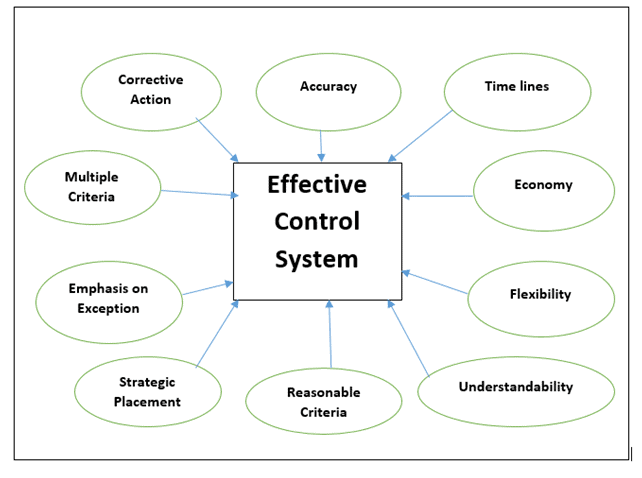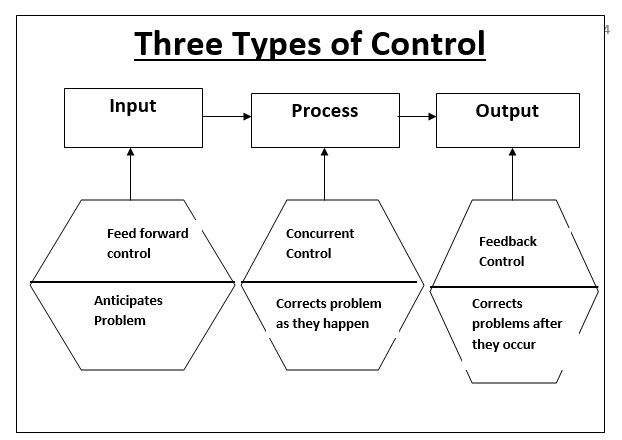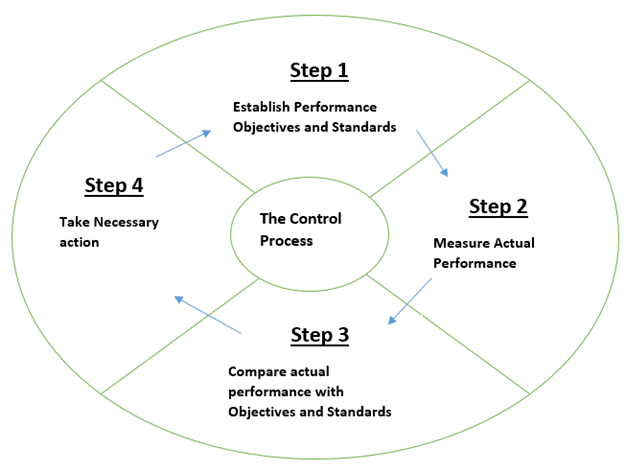Section - I > Managerial Function - Controlling (Managerial Function) - UPSC PDF Download
Controlling (Managerial Function)
Controlling is significant model and process in management. Controlling guarantee that organizational performance is as per standards. Performance standards are often stated in financial terms such as returns, costs, or profits but may also be stated units produced, number of defective products, or levels of quality or customer service. The measurement of performance is done in many ways and it depends on the performance standards, including financial statements, sales reports, production results, customer satisfaction, and formal performance appraisals. Managers at all levels get involved in the managerial function of controlling up to some extent.
The managerial function of controlling must not be confused with control in the behavioural. This function does not mean that managers have any role in controlling or manipulating behaviour of personnel and their values, attitudes, or emotions. This function is related with the manager's role to take necessary actions to make certain that the work-related activities of assistants are regular with and all operations are performed for the attainment of organizational and departmental objectives. Effective controlling needs the existence of plans, since planning provides the necessary performance standards or objectives. Controlling also requires good understanding of where responsibility for deviations from standards lies. Traditional techniques of control are budget and performance audits. An audit process engages in investigating and verifying records and supporting documents. A budget audit provides information about where the organization is with respect to what was planned or budgeted for. Although controlling is determined in terms of financial standards, managers must also control production and operations processes, procedures to deliver services, compliance with company policies, and many other activities within the organization.
It is observed that earlier, managers believed that the need of control emerged when there is lacking something or management functions are not running successfully. Then, control process was performed to identify the person responsible for these events and take actions against him. This is only negative scrutiny of control. In today's business management, the chief purpose of control is to recognize the mistakes or variations as soon as they appear between performance and standard laid down and then to take necessary action to prevent such variations in future. The controlling is mainly intended to get positive results and not people as such. Its purpose is to guarantee that proposed results occur and not that particular workers are criticized.
When analysing theoretical studies, it is established that there have been extensive work done to understand the process of controlling as management function. Theorist, E F L Brech explained that "Control is checking current performance against predetermined standards contained in the plans, with the view to ensuring adequate progress and satisfactory performance". According to renowned theorist, George R. Terry, "Controlling is determining what is being accomplished, that is, evaluating the performance and if necessary applying corrective measures so that the performance takes place according to plans". Several researchers said that controlling is process of monitoring activities to ensure that what is being accomplished matches plans and corrects significant deviations. Henry Fayol defined that control consists in verifying whether everything occurs in conformity with the plan adopted, the instructions issued and the principles established. Another theorist, Koontz and O'Donnell stated that controlling implies measurement of accomplishment against the standards & the correction of deviations to assure attainment of objectives according to plans.
Figure: Qualities of effective control.
Some attributes of controlling as management function are as follows: Controlling is a continuous process. It is flexible and dynamic process. It is future oriented. Planning and controlling are closely related. Main essence of control is action. For Effective Control System, controls need to focus on appropriate activities. Effective controls must focus on critical factors that affect both the individual's and the organization's abilities to achieve objectives. Information needed for comparisons and control purposes needs to be in the management's hands in order to make effective corrective action. Delays in generating, gathering or disseminating information can prolong the occurrence and extent of deviation. Controls must be cost effective. The benefit of using appropriate controls should be worth their cost of installation and operation. Too much control can be worse than too little. The key is to provide appropriate for the situation and provide savings greater than the costs involved. Another characteristic of controlling is that Controls should be precise and concise. Controls must provide information about operations and people in sufficient quantity and quality to enable managers to make meaningful comparisons to operations standards. Controls should be accepted by the people they affect. Main objective of control is to measure the performance, compare to standard and take corrective actions. Mangers can measure the performance through personal observations, management-by-walking about, statistical reports, oral report and written reports. There are three types of control which is shown in figure:

Major steps in control process:
There are three basic steps in a control process that include establishment of standards, measurement of performance and comparing the performance with the standards and taking corrective action.
- Establishment of standards: This is the initial step in control process that establishes the standards of performance. A standard acts as a reference line or a basis of actual performance. Standards should be set accurately and in quantitative terms. Standards expressed in unclear or general terms such as "Costs should be reduced" or "rejections should be reduced" are not specific as "cost should be reduced by 10 percent" or "rejections should be reduced to 0.5 percent". Standards are used as the criteria by which performance is measured in the control process. Since standards cannot be set for entire operations, each organization must first develop its own list of key result areas for the purpose of control. Different standards of performance are developed for various operations at the planning stage. Actually, planning is the basis of control. Standards are to be flexible in order to accommodate in changing business situations. In management practice, different types of standards used are physical standards such as units of production per hour, cost standards, such as direct and indirect cost per unit, revenue standards such as sales per customer, capital standards such as rate of return of capital invested, and intangible standards such as competency of managers and employees.
- Measuring and comparing actual performance with standards: Next step in controlling process is to measure the actual performance of individuals, group or units and compare it with the standards. The quantitative measurement should be performed in cases where standards have been set in numerical terms to make evaluation easy. In other cases, the performance should be measured in terms of qualitative factors such as measuring performance of industrial relations manager. His performance should be measured in terms of attitude of workers, frequency of strikes and morale of workers. Personal observation technique is used to measure the performance such as in the case of the subordinates being observed while they are engaged in work or by a study of various summaries of figures, reports, charts and statements. Once the performance is measured, it should be compared with the standards to distinguish deviations. Some deviations are enviable such as the output above the standard. But some other variations are unwanted such as a variation in the delivery schedule agreed upon with the customer. The measurement and comparison are done at various stages in the total process and not at the end.
- Taking corrective action: The last step in controlling process is to take corrective action so that deviations may not repeat and targeted objectives of the organization are met. This will involve taking certain decisions by the management like re-planning or redrawing of goals or standards, reassignment or classification of duties. It may also require improving the process of selection and training of workers. This control function may necessitate change in all other managerial functions. If the standards are not adequate and faulty, there is a need to establish again through observations. A good control system assists the manager to assess the risks of committing errors.
Figure: Four steps in controlling process:
Control methods:
Control methods are generally categorized into two types that include past-oriented controls and future oriented controls.
Past-oriented controls: Past-oriented control measure results after the process. These are also identified as post action controls. They scrutinize activities occurred in the past for a particular period. Examples of past-oriented controls are accounting records, school grade reports etc. These controls are used to plan future behaviour through reviewing post errors or successes. They can also be used for rewarding, disciplining, training or promoting individuals.
Future-oriented controls: These are also recognized as feed-forward controls or steering controls. These controls are intended to assess results during the process, so that action can be taken before the task is completed or the period is over. Examples of such controls are cash flow and funds flow analysis, network planning which assist managers to observe that they will have problems in such areas of cash or on time delivery unless they take prior action.
Organizations use both these types. Future-oriented controls are vital because the information feedback in them is at the input side of the system, so that improvement can be made before the system output is affected.
Figure: Past-oriented and future-oriented controls 
Current issues in control include rights that manager has to monitor employee behaviour, rights that manager has to control private lives of employees; employers may be able to control employee behaviour outside the work environment.
There are some limitations in controlling process. The first limitation is difficulty in setting quantitative standards: Control system loses some of its effectiveness when standards cannot be defined in quantitative terms. Employee confidence, job satisfaction and human behaviours are such areas where this problem might arise. Second restriction of controlling is little control on external factors. Generally an enterprise cannot control external factors such as government policies, technological changes, and competition. Third limit is resistance from employees. Control is often opposed by employees. They perceive it as restriction on their freedom. Lastly, it is quite expensive as it involves a lot of expenditure, time and efforts.
It can be said that controlling is performed by managers to monitor current performance against pre-set standards contained in the plans in order to ensure good progress and satisfactory performance. Control involves three steps namely establishing standards, measuring and comparing actual performance with standards and taking corrective action. Controlling assists to maintain compliance with essential organizational rules and policies.
FAQs on Section - I > Managerial Function - Controlling (Managerial Function) - UPSC
| 1. What is the role of controlling in managerial functions? |  |
| 2. How does the controlling function help in achieving organizational goals? |  |
| 3. What are the key steps involved in the controlling process? |  |
| 4. How does controlling contribute to organizational effectiveness? |  |
| 5. What are the challenges faced in the controlling function? |  |




















